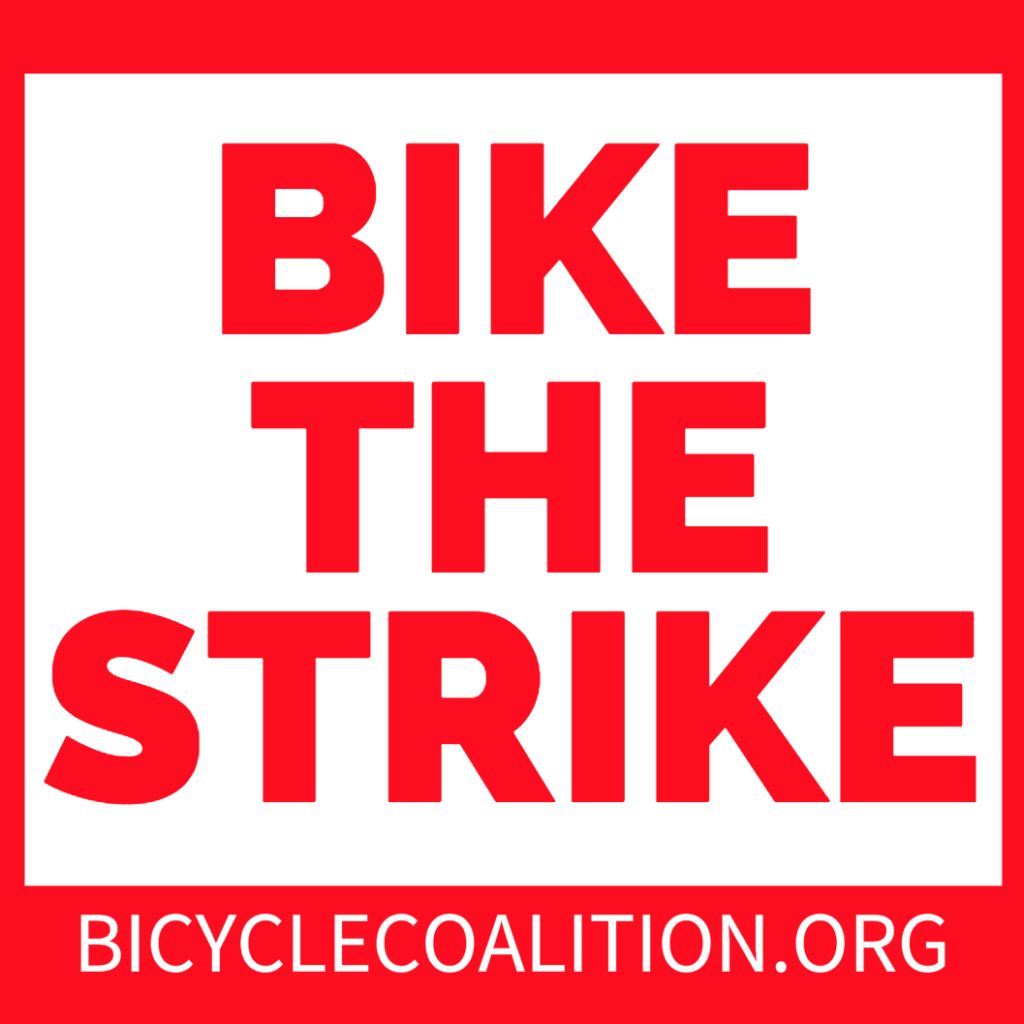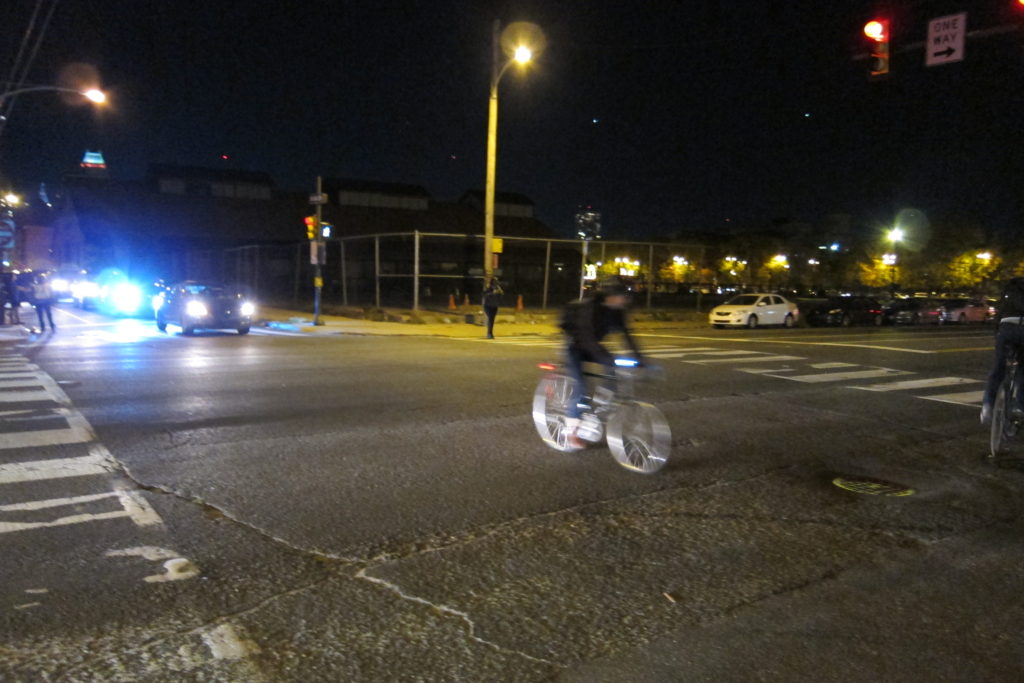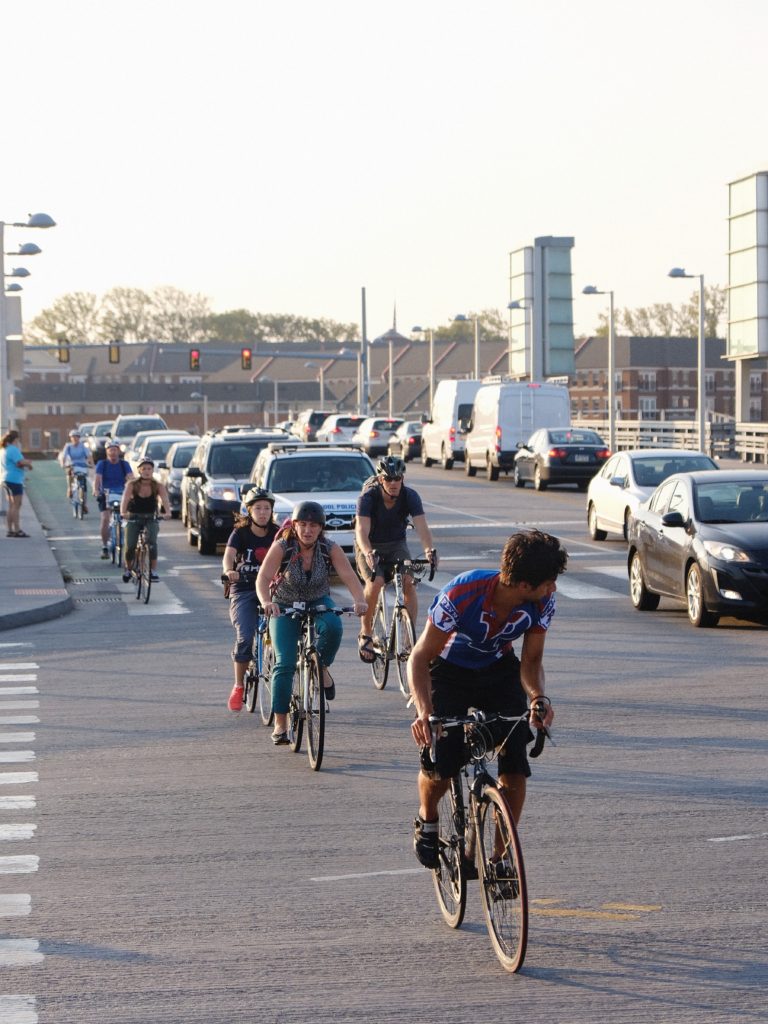
SEPTA management and TWU Local 234 came to an agreement at 5:30am Monday morning, tentatively ending the nearly weeklong transportation strike in Philadelphia.
During the strike, the Bicycle Coalition of Greater Philadelphia came out to help new cyclists get around the city, and park. We greeted cyclists each morning at the Municipal Services Building with bike maps, energy bars, and stickers; we held bike trains into Center City; and we created a new map for cyclists, depicting usable bike lanes, bike share stations, bike shops, and our bike ride meeting spots.
But new cyclists—and there were plenty of them; we’ll get to that in a bit—were just part of the equation. The Bicycle Coalition was also interested in how our membership got through the strike, so we asked them for some feedback.
Cyclists’ Reactions

Ann Dixon:
Normally, I travel to the one at Temple’s medical campus (Broad And Erie) via #34 trolley and Broad Street Line. A 45 minute trip. Since the strike, I’ve been biking from my home in West Philly to City Hall and then taking one of the free Temple shuttles. One and a half to two hours. There’s lots more motorized traffic than usual, of course. There’s mostly enough room for me when biking over the Market Street Bridge and sticking to the far south side of the road at around 7 am. On the return trip, I use JFK Blvd. There would be plenty of room if car drivers would line up. Most do, but a few don’t. This means sometimes biking on the sidewalk to get around them. JFK Blvd: perfect candidate for a bike lane.
Jillian Lopez:
I’m finding that with more drivers on the road, my ride takes longer and feels less safe. I usually go down Chestnut and am used to the right lane being a bike/bus only. Now I’m dealing with cars in “my lane,” many of whom don’t seem used to looking over at all before switching lanes from left to right. I’ve had to increase the defensiveness when it comes to cycling on the way to and from work with so many cars on the street.
Bert Glenn:
There is significantly more traffic, particularly coming home at night. I have to do more maneuvering around and through traffic, and even used a couple of sidewalks (which I never have to do when there is no strike). I have seen a couple more bikes but not too many more on my route. There are actually few cyclists on my route anyway until I get to around Girard going in.
The big risk with the strike is if I get a flat tire I can’t fix or some other disabling mechanical problem. I always have a couple of tokens in my pocket to put my bike on the 47 and get a ride home (or in) and have to do that maybe every two or three months in riding weather. That safety net is not available right now.
So, using my bike has been successful during the strike, even if it has been a bit more work.
Kate Spellissy:
I commute to and from work on an Indego Bike, which I have been doing ever since the program launched about a year and half ago. My bike experience during the strike has been mixed. On one hand, it has been really terrific to see so many people out on bikes (and walking). One of my colleagues is riding 45 minutes to get to the office and this is a person that doesn’t usually get much exercise. Many of these folks though, don’t have very good street etiquette so it would be great (and helpful) to communicate basic rules to the newbies somehow. Also, everyone needs to be that much more vigilant on road safety since there are also a LOT more drivers out there and people are starting to get a bit grumpy. I’m seeing less patience and more driving and parking in the bike lanes.
Andrew Ross:
I normally bike to work anyway, unless poor weather conditions (Old City to Center City – Arch St westbound) – it has not been significantly different, but there is more traffic backing up at 12th, 13th, Broad, 15th and 16th – part of this is construction related as well – going home on Race St, congestion in Chinatown (almost always even pre-strike), and some construction issues at 7th and 6th – thanks, Andrew Ross
Kristen Suzda:
- Where there are dedicated bike lanes, it’s usually fine. Until an annoyed driver does a sudden lane change and drives in the bike lane to get to the red light faster.
- Where there aren’t dedicated bike lanes, it’s slow going. There isn’t enough room to safely or legally scoot past the cars, usually, because they’re staggered all over the place trying to squeeze by to where they’re going. It’s adding a whopping 2-4 minutes to my normal 12-14 minute commute.
- We need more bike parking. Normally I enjoy this time of year, because I bike all year, and by November most of the fairer weather cyclists have given up and I can actually get my bike in and out of the racks at my building. Now, I’m not even bothering (bikes are literally on top of each other on our racks right now), and I’m riding up the ramp in the adjacent parking garage for the inconvenient secret bike racks there. You should consider compiling lists of not-so-well-known bike parking in places like parking garages, where it is often hidden in some inconvenient location because that’s where there’s left over space. There are not enough sign posts or old parking meter posts in this town! Also, a guide to how-not-to-be-a-jerk when parking a bike would be awesome, but that’s probably asking too much! 🙂
Were More Biking the Strike?

Photo: Dan Chabanov
Yes. Lots more biked during the strike—and with more people riding bikes and driving cars, it drove home that cyclists need better, safer infrastructure.
As a normal commuter, I witnessed a lot more cyclists to and from Center City on my regular trips. And the Bicycle Coalition and other groups also held bike counts throughout the week to see how many more people were cycling.
The results were staggering. Our volunteer counted 609 total bikes per hour during rush hour at 13th and Spruce—an increase of 53 percent over 2014 morning counts.
On the South Street Bridge, Bicycle Coalition staff members Waffiyyah Murray counted 521 bicycles per hour during Friday’s rush hour—an increase of 29 percent over Fall 2015 morning counts.
Even less-traveled routes saw increases in cyclists.
The Chestnut Street bridge saw 140 bikes per hour during rush hour, an increase of 37 percent when compared to 2015 morning numbers. Walnut Street: 194 bikes per hour, an increase of 34 percent. And Market Street averaged 133 bikes per hour during rush hour, a whopping 75 percent increase when compared to 2015’s morning counts.
There were some problems, though
Cyclists noted, and Bicycle Coalition staff had discussed here, that many motor vehicle users simply don’t understand what paint on our streets means. This tends to happen to everyday cyclists, but is extremely dangerous when new cyclists are riding alongside inexperienced urban drivers. On my personal ride, I saw drivers thinking North 13th Street was a two vehicle lane road in some cases; and simply ignoring the Spring Garden bike lane in other cases.
Some others noticed that drivers were particularly angry this week, as many were probably not used to driving in the city. There’s no excuse for the type of behavior many saw—but there is a way to avoid it. Creating a physical separation between bicyclists and motor vehicle drivers will create a barrier that lets drivers know where they are, and are not, allowed to be.
This is something the Bicycle Coalition of Greater Philadelphia has continually been advocating for—and what our Executive Director, Sarah Clark Stuart, spoke on at this past weekend’s Philadelphia Bike Expo. We will have more on that later this week.

I meant to submit my experience, but I forgot. I ride from South Philly to Center City, via Moyamensing and then up 3rd, or sometimes 5th St. I did notice more traffic, both bike and car traffic. I take Spruce St. to get to 13th St. and there were a LOT more bicyclists than usual. Most did not obey the red lights, but that’s a regular occurrence and not unique to the strike. Overall, it seemed like the car drivers did not know what they were doing anywhere. I saw a lot of confused drivers who didn’t understand that finding parking in Center City is next to impossible on most days. Biking was definitely the best way to get around and avoid sitting in traffic.
Bike commuting from Pennsport to Fairmount during the strike was just what I expected: more congestion, but not that much worse than usual (13th was the exception: solid cars Vine to Spring Garden every morning). I definitely knew the strike was over on Monday, though, as two different buses tried to run me off the road on 17th St. In Center City.
I have been biking from Ardmore to Center City for about 8 months now. there are about a dozen riders that I see routinely between Memorial Hall and my home. this didn’t change much during the strike.
The riders in the city seemed to increase significantly and as many commented above, the new riders seemed to have trouble with the new drivers. I find Pine a much better alternative to Chestnut if you are going any distance.
I also firmly believe that riders should pay attention to traffic lights and stop signs. riders need to share the road with cars and it is safer for the riders and the cars if everyone follows the same rules.